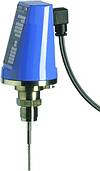Measuring slurry level under foam
July 2001
Level Measurement & Control

Precious metal extraction processes have certainly evolved over time. The value placed on such commodities has allowed technology to improve the processes thus generating higher yields than ever before.
Extraction involves the slurry being pumped into flotation cells or vessels, together with special reagents, a regulated air supply and with agitation the slurry begins to froth, producing the 'mechanism' for extraction. The quantity of extraction is dependent on pH, flowrate, percentage base metal in the slurry and also the size of the air bubbles, the latter playing a vital role. Once some of these variables have been stabilised, the varying air bubble size results in a greater or lesser entrapment surface area. The foam layer with the entrapped metals is floated off through several stages resulting in a higher concentration for processing.
Critical to the entire principle is the control of the slurry level, hence the amount of foam produced and overflowed. Should this not be achieved within pre-defined limits, then the overflowed slurry will result in poorer yields.
Traditional level measurement featured various hybrids ranging from buoyancy transmitters, angular displacement transmitters to ultrasonic level transmitter using floats attached to some rather exotic mechanical devices to represent the level. This buoyancy type measurement is density-dependent, hence variations to the air supply result in level changes whilst in actuality the only variation is density. Further, due to turbulences, some of these mechanical systems endure great forces and at times, dependent on position, are rendered inoperable due to the restraint of movement. Product build-up on the floats and guide mechanism also result in erroneous measurements thus necessitating periodic maintenance. The proximity of the ultrasonic transducer relative to the agitator bearing sets also has been a source of problems. Some sets have been known to generate sporadic noises in the ultra-sound range resulting in false echoes for the transmitter.
The Krohne TDR level transmitter utilises a rod as a guide for the microwaves. This already guarantees immunity against noise, is independent of density variations, is less susceptible to build-up because of the reduced surface area, making it maintenance-free, and provides the correct level of the slurry under turbulent conditions. The rod can even be bent to a 90° angle to facilitate ease of mounting. Krohne believes that the BM100/102 with its patented proven technology, various successful site tests, option of two-wire at attractive price and reduced cost of ownership, has revolutionised this area of measurement.
Krohne
(011) 315 2685
Further reading:
VEGA is redefining synthetic fuel production
VEGA Controls SA
Level Measurement & Control
Polish company, Ekobenz specialises in producing bio-hydrocarbons. The company utilises advanced manufacturing techniques where VEGA sensors monitor levels and interfaces, essentially overseeing separation layers in the process.
Read more...
Precision in paper processing
VEGA Controls SA
Editor's Choice Level Measurement & Control
Paper manufacturing is a demanding process that relies on consistency, precision and control at every stage. The VEGABAR 82 pressure transmitter is well-suited to these harsh environments.
Read more...
Where every grain counts
VEGA Controls SA
Level Measurement & Control
VEGA’s advanced level and pressure measurement solutions offer transformative technologies to improve grain storage management in sub-Saharan Africa.
Read more...
Small, inexpensive radar level transmitters
VEGA Controls SA
Level Measurement & Control
Anyone who needs to keep processes running needs level measurement technology that measures reliably. However, what is needed is not always the most ‘fully featured’ solution, but the smartest one. This is exactly what VEGAPULS radar transmitters of the BASIC series do.
Read more...
Meeting the challenges of tank obstructions interfering with radar
Level Measurement & Control
One of the most challenging applications for non-contacting radar level transmitters is measuring level in tanks with internal obstructions, such as agitators, heating coils, pipes, ladders or baffles. Rosemount non-contacting radar level transmitters from Emerson feature an advanced solution that enables accurate and reliable level measurements in tanks with obstructions.
Read more...
A fresh approach to dairy processing
VEGA Controls SA
Level Measurement & Control
Ensuring the quality and safety of milk throughout the production process is of the utmost importance in the dairy industry. The VEGABAR pressure transmitters are suitable for hygienic applications. They are an asset in the dairy industry and have been used with success for measuring the milk level and the process pressure in storage tanks.
Read more...
Multiphase level measurement
Mecosa
Level Measurement & Control
The measurement of more than two phases or of interfaces that are not clearly defined poses a number of challenges for measurement technology. Radiation-based measuring systems such as Berthold‘s EmulsionSENS master these problems.
Read more...
Simple and efficient level measurement in the mining, minerals and metals industries
Endress+Hauser South Africa
Editor's Choice Level Measurement & Control
Measuring devices in the mining, minerals and metals industries face the challenge of varying material states and long distances in measurement height. Endress+Hauser’s answer to these challenges is the new Micropilot family.
Read more...
Level measurement of an acid dosing tank at a WWTP
Level Measurement & Control
Ferric chloride and other acids are essential chemical substances in water and wastewater treatment. To control the dosing of acid solutions, an Australian wastewater treatment plant uses a special container to store, mix and add these chemicals. The company opted in favour of KROHNE’s OPTIWAVE 1540 radar level transmitter
Read more...
Powering sub-Saharan Africa’s energy future
VEGA Controls SA
Level Measurement & Control
Crude oil storage plays an important role in the energy infrastructure of sub-Saharan Africa. The management of crude oil storage in comes with numerous challenges, including safety concerns, environmental conditions and infrastructural limitations.
Read more...


